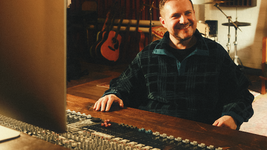Andreas Gursky Exhibition - Hayward Gallery
- Irina Anghel
- Jan 26, 2018
- 4 min read
25 January - 22 April 2018
Prices: £16 - £7.25 (Members go Free)
A multitude of tiny dark individuals assemble, dissolve and assemble again in the bright interior of an art gallery, as if led by an invisible hand. If you pause or fast-forward their motion at a high rate, this could be an Andreas Gursky picture hanging on the walls of the same art gallery. However, this is actually the “Andreas Gursky” exhibition at the Hayward Gallery of the Southbank Centre.

The German photographer Andreas Gursky is proclaimed to be the chronicler of the global economy. One of the most influential picture-makers of our time, his images are large-scale encyclopaedias of modern life, capturing both architectural landscapes and natural habitats of capitalism, restless crowds and seemingly empty spaces.
The first major UK retrospective of the artist inaugurates the newly refurbished Hayward Gallery, which also celebrates its 50th anniversary this year. Gursky himself acknowledges that any exhibition of his photographs is a challenge due to their larger-than-life scope and size: each work demands its own wall; disobey that demand and you get a clash of titans. Nevertheless, the sixty-eight images in exhibition are in perfect symbiosis with the naturally lit open spaces and brutalist architecture of the Hayward Gallery.
Gursky’s images are arranged chronologically, guiding us through the evolution of the artist’s technique and themes, as well as that of the world itself. The journey starts in the 1980s with his early landscapes exploring the structures of nature and their relationship with their inhabitants. These provide clues of the elements which will become his trademarks in the following decades: the epic size of the images, the distant perspective, the idea of simultaneity a sense of predetermination and peacefulness, sometimes disrupted, other times enhanced by the presence of people who are never individuals, but representatives of a community; the addictive uneasiness experienced by the viewer.

The tipping point occurs in the 1990s: Gursky’s new interest in industrial environments and ‘aggregate states’ gains new depths, both literally and figuratively, with the discovery of digital manipulation. “Salerno I” (1990), marking the artists’ change in gears, is a large-scale depiction of the harbour of an Italian port town as a flat world “without hierarchy”, in which each element is uncannily well-defined. To do so, he juxtaposes images from multiple vantage points, and digitally enhances or removes certain details in his pictures.
His most iconic photographs are all constructed in this way. “Paris, Montparnasse” (1993), which presents the largest Parisian block of flats, combines images taken from two viewpoints across the street. As each grid of windows is presented with equal focus, the viewer is tempted to zoom in the lives of the inhabitants. However, a remake of Hitchcock’s “Rear Window” is made impossible by the colourful blinds reminding of Mondrian; the closer you look, the less you understand - the viewer thus remains forever trapped on the outside.
“99 Cent” (1999, remastered 2009) is another such unsettling depiction of a familiar setting: we are now looking at the epic-sized, high-definition version of full-packed, colour-coded shelves in a discount store where everything is a copy of a copy of a copy, or, put simply, consumerism in technicolour.
The logic of collective action is explored by Gursky through his images overviewing busy trading floors in different locations across the globe. “Tokyo, Stock Exchange” (1990) shows thousands of nameless dark-suited individuals roaming around as if in a bee hive. Again, multiple shots are used to convey an augmented feeling of simultaneity, leading the viewer to feel torn between what seems to be an infinite number of focus points.
The artist’s more recent works distinguish themselves by slightly more provocative interpretations of previous compositions. Whilst Gursky’s earlier works presented naked facts leaving the viewer to puzzle over what to make of them, there is now some meaning to be found in the choice of subjects which are deeply anchored in our reality. The budget store is now named: either a full-packed Amazon storage space in “Amazon” (2016), or a Prada store, whose eerie candy-coloured shelves have been emptied in “Prada II” (1997), natural landscapes are now replaced by the spectacular choreographies of the Mass Games in North Korea in “Pyongyang VI” (2007, 2017) and “Pyongyang VII” (2007/2017).

Another important theme is the interplay between nature and technology. In “Les Mées” (2016), a photograph of a solar park in France, the solar panels appear to be an organic extension of the hills they cover, rounded by the same rhythm as them. We are left to wonder what to make of the ease with which technology seems to be replacing nature.
Despite the extensive use of digital manipulation, Andreas Gursky remains more of a God than a central planner, a true wizard, not just a magician. Each of his images is not a window, but a screen through which we observe paused or fast-forwarded hyper-realities. It is this unique vantage point, located somewhere outside the conventions of time and space, in which he places ourselves that defies our expectations about what an image should show and how we should look at it.

































